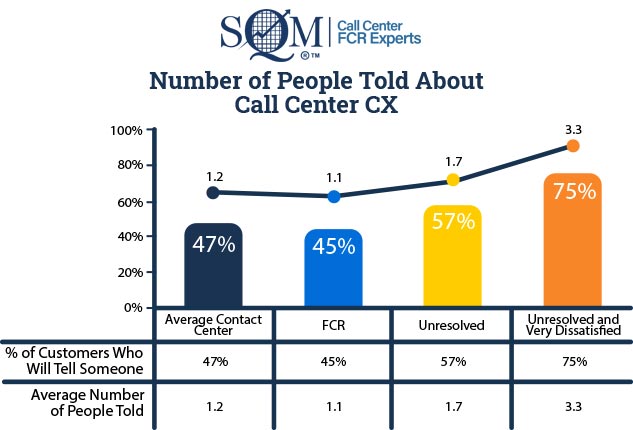Customer Behavior When Service is Poor
According to SQM research, 14% of customers who call a contact center would define the reason for their call as a complaint they have with the company's service or product. Unfortunately, the call center agent handling the complaint worsened the situation in many cases. Many managers are surprised to discover that such a high number of customers would describe their contact reason as a complaint call.
Furthermore, most managers are unaware of customers' behaviors after they experience poor service using a call center. SQM's research shows that when service is poor, the following customer behavior occurs such as 32% do nothing, 29% tell someone at the organization, 28% tell friends or family, 6% stop doing business with the organization, and 4% post a negative rating or review.
When customers experience poor service using a call center, they are most likely to…

Furthermore, when customers say they will do nothing, their complaint tends to be minor or a low dollar amount. However, the call centers missed an opportunity to provide service recovery. When an agent does a great job handling a customer complaint, it is not uncommon for the customer to be even more loyal to purchasing the company's products and services.
When it comes to telling someone at the organization, many customers will ask for a supervisor or manager to discuss to help them resolve their complaints when they are not satisfied with how the agent is handling their call. It is a common practice that when a customer request to talk to a supervisor, the agent transfers them to an escalation agent to resolve the complaint. A best practice for an escalated call is to conduct a post-call survey to determine the customer's satisfaction.
Many customers tell friends or family about the poor customer service they experienced using a call center. Interestingly, when CX is poor, customers share their stories with someone they know well. Customers often feel it is easier to tell friends or family about their poor service with someone they know well versus individuals they don't know.
But, most alarming is dissatisfied callers stop doing business with the organization due to the poor call center customer service they experienced. Furthermore, if the call was unresolved, 23% of customers expressed their intent not to continue using the organization's products and services due to their call center CX. In addition, it costs five times more to attract a new customer than to retain one.
Also very concerning is when a customer has a poor experience using a call center, they can post a negative rating or review feedback about a company that potentially can go viral. In addition, it is not uncommon for a customer to record the call to the contact center and share it on social media, which will go viral. There are plenty of examples of a poor customer service story recorded and shared via social media being heard by five million people in just a few days.
Sharing CX Using a Call Center With Others
Most call center leaders do not know the percentage of customers who tell someone about their experience. When we share their data, they are surprised to discover how low it is for poor or great customer service. SQM research shows that for the call center industry, on average, only 47% of customers will tell someone about their experience calling a call center and will tell, on average, only one person.
Customers are more likely to remember an unresolved call and are very dissatisfied. As a result, they will tell more people than if they had experienced First Call Resolution (FCR). For example, SQM research shows that 75% of customers whose call was unresolved and very dissatisfied with their call center experience will tell three people about their poor experience. Put differently, callers dissatisfied (unresolved call) with their call center experience will tell three people, and satisfied customers (FCR achieved) will tell only one person.

